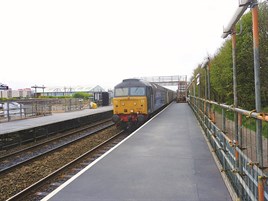It’s not hard to believe that the weather can play havoc with the Cumbrian Coast line.
Travelling towards Workington it was sunny above, but out to sea southern Scotland was shrouded in mist and rain. At Maryport the wind whipped along the single platform, with the small shelter providing little protection against the icy April winds.
The land is low and the railway kisses the sand dunes and the beach. It is also relatively flat - in the distance are the Lake District fells, but the dwellings of Maryport, Flimby and Workington are low-lying.
When storms lashed the coast and the Lake District on November 19 and 20 they had the sort of effect on the local infrastructure more familiar on television news broadcasts from overseas.
Bridges were smashed and communities torn apart after more than 300 millimetres of rain fell in the area in just one day. Some areas were eight feet deep, as water surged off the fells and into the River Derwent. The torrent of water rushed downstream and through Workington, taking a number of bridges with it.
The prominent one was that which carried the A597 into the town. This bridge connected both sides of the town, but when it was destoryed (RAIL 633), the community was split into two. Simple tasks such as shopping, going to school and visiting friends became incredibly difficult - it involved a 50-mile car journey to complete what was previously a five-minute trip.
Arriving in the town by train from the north presents two contrasting views. To the right the Derwent winds towards the sea, with pleasure craft bobbing in the waves. In the distance, the docks can be seen. To the left you look inland and just around the first bend is the road bridge that opened on April 20, the bridge funded by the Department for Transport to replace the original A597 crossing. But just in front of that are two very large protruding lumps of brick in the Derwent. These are the remains of the A597 crossing - a reminder of what Mother Nature is capable of.
But one structure stood strong… the railway bridge.
Northern Rail is the local train operating company (TOC) and runs passenger trains along the coast, but these were roughly hourly.
Four miles north of Workington is Flimby, which had been a request stop. Residents quickly flocked to this station and Northern’s trains, which had been busy at peak times but probably not to a level that could be described as overcrowded, suddenly found themselves ‘full and standing’. Northern Performance and Planning Director Rob Warnes says it was immediately obvious that “rail was an attractive solution to an acute problem”.
He explains: “Communities north of the river faced with a detour, and then sat in huge traffic jams, soon realised that rail was quick and easy.”
The trains, though, could not cope with the huge volumes. Where 20 or 30 people used to board, there were now up to 500 waiting for a two-car train. And the timetable along the coast is structured to serve different areas at different times.
“There is no commute from the north to Workington and the timetable is based around getting the workers to Sellafield. There is a regular commute up to Carlisle including a lot of college flows, but most traffic is to Sellafield,” says Warnes.
At the time there were no resources, or train crew, to increase the service. Northern, like so many TOCs, is struggling to provide capacity for existing flows, let alone surges such as this.
“Initially we saw huge volumes,” says Warnes. “We moved units from West Yorkshire and Greater Manchester, but that meant short-forming trains in those areas during that week.” (Leeds and Manchester are two of Northern’s busiest areas and already suffer chronic overcrowding, so there was a real problem).
On the coast, a timetable change was implemented. The 0744 Carlisle-Whitehaven was terminated at Workington and then ran to Maryport. Northern ran a bus down to Whitehaven to complete the original journey. This, says Warnes, was not sustainable.
















Login to comment
Comments
No comments have been made yet.